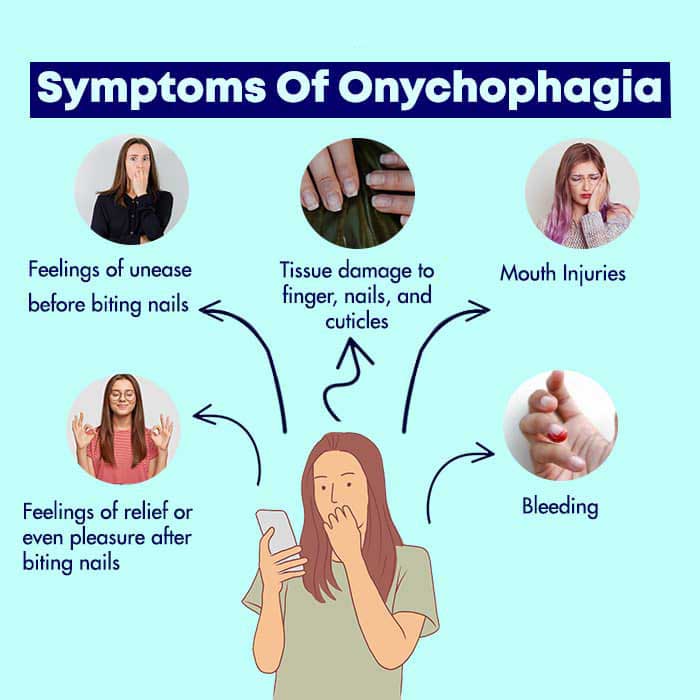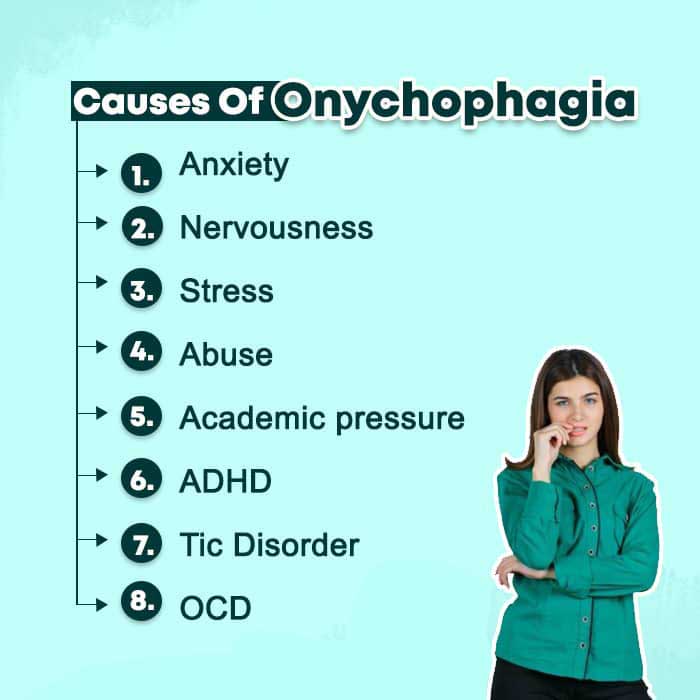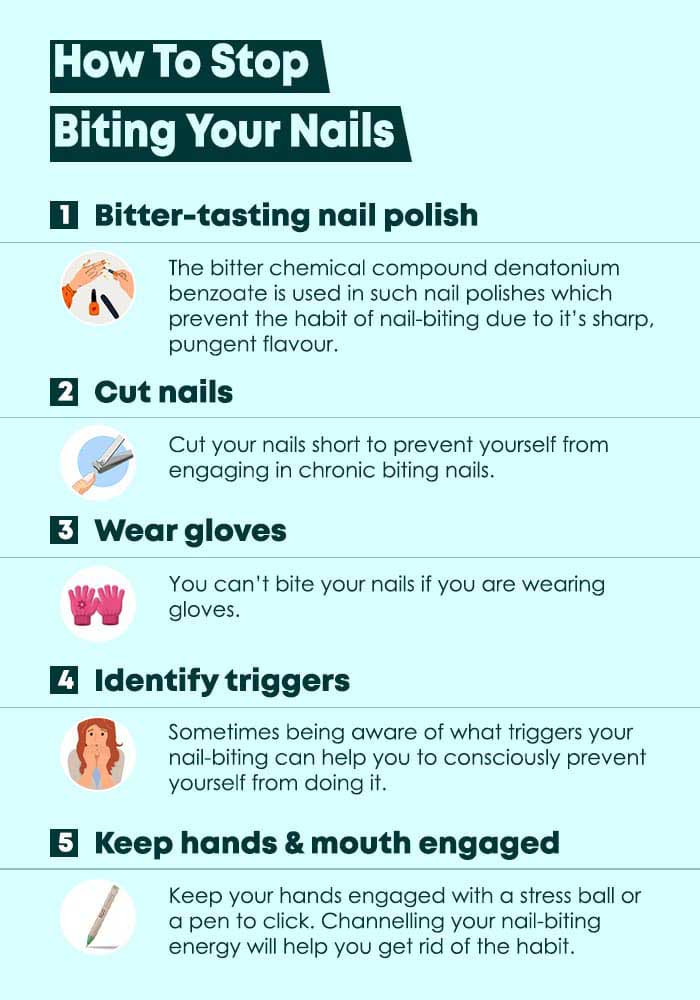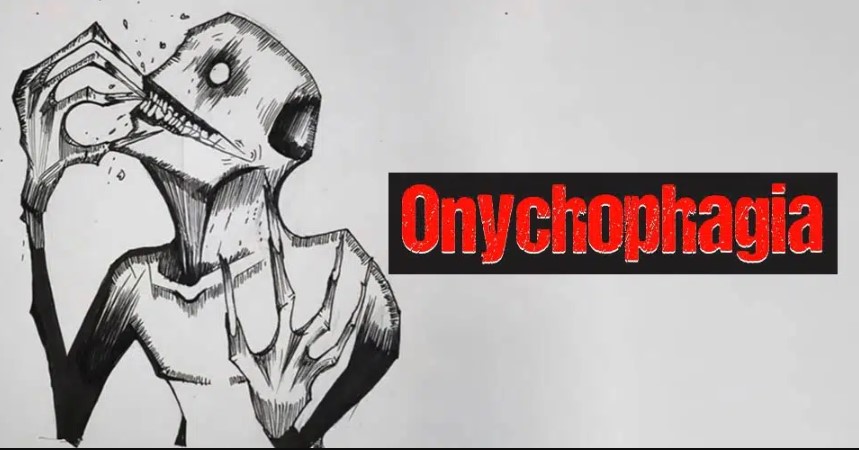Do you chew your nails constantly? Are you unable to stop? Onychophagia or nail-biting is a non-destructive chronic habit that involves biting one’s fingernails and is commonly observed in both children and young adults.
What Is Onychophagia?
Onychophagia, also known as onychophagy, is primarily a grooming disorder. It is a pathological oral habit that involves uncontrollable & chronic nail-biting, which can be damaging for the fingernails & adjacent tissue. According to the Medical Journal [mfn] Pacan, P., Grzesiak, M., Reich, A., & Szepietowski, J. C. (n.d.). Onychophagia as a spectrum of obsessive-compulsive disorder. Welcome to Medicaljournals.se – Acta Dermato-Venereologica – Journal of Rehabilitation Medicine – Forum for Nordic Dermato-Venereology. https://www.medicaljournals.se/acta/content/abstract/10.2340/00015555-0646 [/mfn], “onychophagia is characterized as a spectrum of obsessive-compulsive disorder.” Research suggests that around 20-30% [mfn] Pacan P, Reich A, Grzesiak M, Szepietowski JC. Onychophagia is associated with impairment of quality of life. Acta Derm Venereol. 2014 Nov;94(6):703-6. doi: 10.2340/00015555-1817. PMID: 24535041. [/mfn] of the general population suffer from chronic nail-biting behaviour.
Nail biting is considered an impulse control disorder and is classified under “Other Specified Obsessive-Compulsive and Related Disorder” in the Diagnostic and Statistical Manual of Mental Disorders (DSM-5). However, the ICD-10 classifies this disorder as “Other specified behavioral and emotional disorders with onset usually occurring in childhood and adolescence.”
Even though onychophagia may appear as a normal behavior, many people, especially children, engaging in nail biting often find it difficult to overcome the habit. If left untreated, it can not only affect the person’s quality of life, but may also lead to other mental and physical health issues. However, with effective treatment and support from family, nail biting can be stopped successfully.
Onychophagia is associated with several other disorders like Excoriation Disorder (skin picking, Dermatophagia (Skin biting) and Tricholillomania (hair pulling).
Understanding Nail Biting Disorder
Nail biting is a compulsive oral habit that usually develops at an early age. Almost 28 to 33 percent of kids bite their nails, according to studies. It is often considered as a parafunctional habit, which refers to the habitual use of the mouth for additional purposes other than eating or speaking. Although it is a temporary and cosmetic condition, this may become a serious issue in the long run.
The American Journal of Orthodontics and Dentofacial Orthopedics explains [mfn] Tanaka, O. M., FarinazzoVitral, R. W., Tanaka, G. Y., Guerrero, A. P., & Camargoe, E. S. (2008, August). Nailbiting, or onychophagia: A special habit. ScienceDirect.com | Science, health and medical journals, full text articles and books. https://www.sciencedirect.com/science/article/abs/pii/S0889540608000048 [/mfn] that nail-biting can often develop due to stress, anxiety, loneliness and inactivity. Moreover, it can also be a result of a habit of thumb-sucking, poorly maintained nails as well as heredity and genetic factors.
Although biting nails with teeth is widely considered as onychophagia, people with this disorder do this habitually and are unable to control this behaviour. Most of the time, this behaviour is limited strictly to fingernails and sufferers don’t usually have any particular preference for any specific fingernails. One 2012 study [mfn] Sachan, A., & Chaturvedi, T. P. (2012, September 1). (PDF) Onychophagia (Nail biting), anxiety, and malocclusion. ResearchGate. https://www.researchgate.net/publication/235669071_Onychophagia_Nail_biting_anxiety_and_malocclusion [/mfn] revealed that it may be a mechanism to cope with stress. Most children and adults tend to engage in nail biting when they are anxious, stressed, bored or even hungry.
In fact, Onychophagia may also lead to other mental and emotional disorders. According to a 2011 study [mfn] Ghanizadeh A. (2011). Nail biting; etiology, consequences and management. Iranian journal of medical sciences, 36(2), 73–79. [/mfn], other psychiatric disorders may co-occur along with Onychophagia. The study states that common co-occurring psychiatric disorders include “attention deficit hyperactivity disorder (74.6%), oppositional defiant disorder (36%), and separation anxiety disorder (20.6%).”
Symptoms Of Onychophagia

Onychophagia is usually associated with the biting of fingernails but it may occur with other body focused repetitive behaviors (BFRBs), such as hair pulling or skin picking. Symptoms are quite visible and people who bite their nails may experience:
- Feelings of unease or tension before biting nails
- Feelings of relief or even pleasure after biting nails
- Feelings of shame, embarrassment, or guilt that are related to the physical appearance of the nails
- Tissue damage to finger, nails, and cuticles
- Mouth Injuries
- Abscess
- Infection
- Dental problems
- Bleeding
Onychophagia can start during childhood, and is common during adolescence. However, this behavior may decrease or stop with age, when treated in time.
Causes Of Onychophagia

Usually, onset is not observed before the age of 3-4 years. Although the exact reason for the development of this disorder is yet to be known, people who are anxious, nervous or depressed are more likely to be affected. It is important to take into account that people with onychophagia do not usually bite their nails during social interactions. Hence obsessive-compulsive disorder can be ruled out as a cause of Onychophagia.
Here are some of the probable reasons why an individual may develop Onychophagia:
1. Psychological Factors
Some of the most common psychological factors include:
- Inappropriate motor activity
- Anxiety
- Boredom
- Nervousness
- Emotional Distress
- Hunger
- Stress
- Fear
Read More About Boredom Here
2. Psychosomatic Factors
There are some psychosomatic causes as well that may affect someone emotionally and can lead to nail biting, such as:
- Domestic violence
- Abuse
- Changes in the family unit
- Academic pressure
- Low self-esteem and insecurity
3. Genetic Factors
There may be a genetic link to Onychophagia as some people appear to have inherited the tendency towards BFRB disorders. Onychophagia is often associated with:
- ADHD (Attentional Deficit Hyperactivity Disorder)
- OCD (Obsessive-compulsive Disorder)
- Oppositional Defiant Disorder
- Separation Anxiety Disorder
- Enuresis
- Tic Disorder
- Tourette Syndrome
Read More About Obsessive-Compulsive Disorder Here
Can Nail Biting Be Physically Harmful?
Nail-biting usually has harmful effects on the fingers like infections or fungal growth. In addition to mental health problems, this disorder can also cause various physical problems, like:
- Stomach infections
- Fungal Infections on the surface of the nail (onychomycosis) and surrounding skin (paronychia)
- Teeth Root Resorption
- Alveolar destruction
- Intestinal Parasitic infection
- Temporomandibular Joint Pain and dysfunction
Treatment Of Onychophagia
There are a number of treatment options for Onychophagia. Therapy and other self-help strategies can help sufferers to successfully overcome the chronic habit of nail-biting. Here are some helpful and most effective treatment approaches:
1. Cognitive Behavioral Therapy (CBT)
CBT [mfn] Morand-Beaulieu, S., O’Connor, K. P., Richard, M., Sauvé, G., Leclerc, J. B., Blanchet, P. J., & Lavoie, M. E. (2016). The Impact of a Cognitive-Behavioral Therapy on Event-Related Potentials in Patients with Tic Disorders or Body-Focused Repetitive Behaviors. Frontiers in psychiatry, 7, 81. https://doi.org/10.3389/fpsyt.2016.00081 [/mfn] helps patients understand their own thoughts, emotions and beliefs and enables them to realize that their habits and behaviours may be distorted or inaccurate. They are then challenged with difficult tasks to perform in order to channelize the nail-biting behavior. It empowers them to deal with the difficult and negative emotions, like shame and guilt, associated with nail biting. Moreover, it makes patients more aware of the triggers and the accompanying desires and urges.
Read More About Cognitive Behavioral Therapy Here
2. Habit Reversal Training (HRT)
HRT is used to unlearn the habit of nail-biting and replace it with a new habit. This training has proven effective in most cases. A study [mfn] Ghanizadeh, A., Bazrafshan, A., Firoozabadi, A., & Dehbozorgi, G. (2013). Habit Reversal versus Object Manipulation Training for Treating Nail Biting: A Randomized Controlled Clinical Trial. Iranian journal of psychiatry, 8(2), 61–67. [/mfn] on Onychophagia revealed that the results from HRT were more effective than placebos or any other forms of treatment. It is used to put focus on the destructive habits of the sufferer to help them gain better self control. Habit Reversal Training is done by watching yourself in the mirror and describing the action each time you bite your nails. Once the patient becomes aware of their habits, a competing response is developed. This means that a new habit is set in motion by replacing the old habit.
Apart from CBT and HRT, acceptance and commitment therapy (ACT) and progressive muscle relaxation techniques can also be effective in overcoming this behavior.
3. Stimulus Control
This form of therapy is used to identify and eliminate the stimulus that frequently triggers the biting urge. By stimulating the factor that triggers the behavior, onychophagia can be controlled. It involves reducing environmental cues and triggers that make biting nails more difficult and removing positive reinforcements.
4. Prescribed medication
The efficiency of drugs is very limited and is not usually prescribed for onychophagia patients. A clinical trial in children and adolescents indicated that N- acetylcysteine, glutathione, and glutamate modulator has shown significant results.
5. Dental devices
The usage of dental deterrent devices is also found among onychophagia patients. Such devices prevent the front teeth from damaging the nails and the cuticles. Research has shown that after two months the device has proved to be an excellent method for treating patients with onychophagia. Moreover, studies [mfn] O. Marouane, M. Ghorbel, M. Nahdi, A. Necibi, N. Douki, “New Approach to Managing Onychophagia”, Case Reports in Dentistry, vol. 2016, Article ID 5475462, 5 pages, 2016. https://doi.org/10.1155/2016/5475462 [/mfn] have found that even “stainless steel twisted round wire bonded from canine to canine” can also help in effective treatment.
Other treatments involve self-help techniques or the use of wristbands as non-removable reminders. Some technology companies have begun producing wearable devices and smartwatch applications in order to curb this issue.
Self-Care For Onychophagia

If you or someone you know is affected by this condition, then it may be difficult to help them unless you are aware of the condition. Prevention or healing cannot happen overnight. So if someone you know or you are suffering from onychophagia, here are some tips that can help.
1. Bitter-tasting nail polish
There are several nail polishes specifically designed with bad flavours to help people suffering from onychophagia. This is perhaps the most common self-help tool used for the treatment of nail-biting. Usually, The bitter chemical compound denatonium benzoate [mfn] Allen, K. W. (1999, February 26). Chronic nailbiting: A controlled comparison of competing response and mild aversion treatments. ScienceDirect.com | Science, health and medical journals, full text articles and books. https://www.sciencedirect.com/science/article/abs/pii/000579679500078X?via%3Dihub [/mfn] is used in such nail polishes which prevent the habit of nail-biting due to it’s sharp, pungent flavour.
2. Cut nails
Cut your nails short to prevent yourself from engaging in chronic biting nails. Since there’s not enough to chew on, it won’t be that satisfying.
3. Wear gloves
You can’t bite your nails if you are wearing gloves. However, if wearing gloves is interfering with your daily life, you can use stickers that cover nails. It has proven highly effective in onychophagia patients.
4. Identify triggers
Sometimes being aware of what triggers your nail-biting can help you to consciously prevent yourself from doing it. Once you know what triggers the behavior, you can try to find ways to cope with it.
5. Keep hands and mouth engaged
Keep your hands engaged with a stress ball or a pen to click. Chew gum so your mouth has other things to do besides chewing your nails. Channelling your nail-biting energy will help you get rid of the habit.
If you have trouble adopting these simple habits, give it a little time. Set small goals and try to not bite your nails for a week and then expand the time frame as you finish your goals. If you still can’t control the urge to bite your nails, consider seeking help from a doctor. A health professional can help you understand the real issue and eliminate the habit through therapy and medication.
Recuperation From Onychophagia
About 30 percent of children between 7 to 10 years and 45 percent of teenagers engage in nail-biting. Although it’s a very common issue, there are several preventive measures that can be taken to recover from this habit.
Self-determination is largely an important factor to help you overcome this behavior. With therapy and a consistent routine, you can actually beat onychophagia and live a much healthier lifestyle.
Onychophagia At A Glance
- Onychophagia or nail-biting disorder is a non-destructive chronic habit that involves biting one’s fingernails.
- Onychophagia can start during childhood, and is common during adolescence.
- Nail biting is considered an impulse control disorder
- Usually, onset is not observed before the age of 3-4 years.
- People with this disorder do this habitually and are unable to control this behavior.
- Nail-biting usually has harmful effects on the fingers like infections or fungal growth.
- Therapy and other self-help strategies can help sufferers to successfully overcome the chronic habit of nail-biting.










Leave a Reply